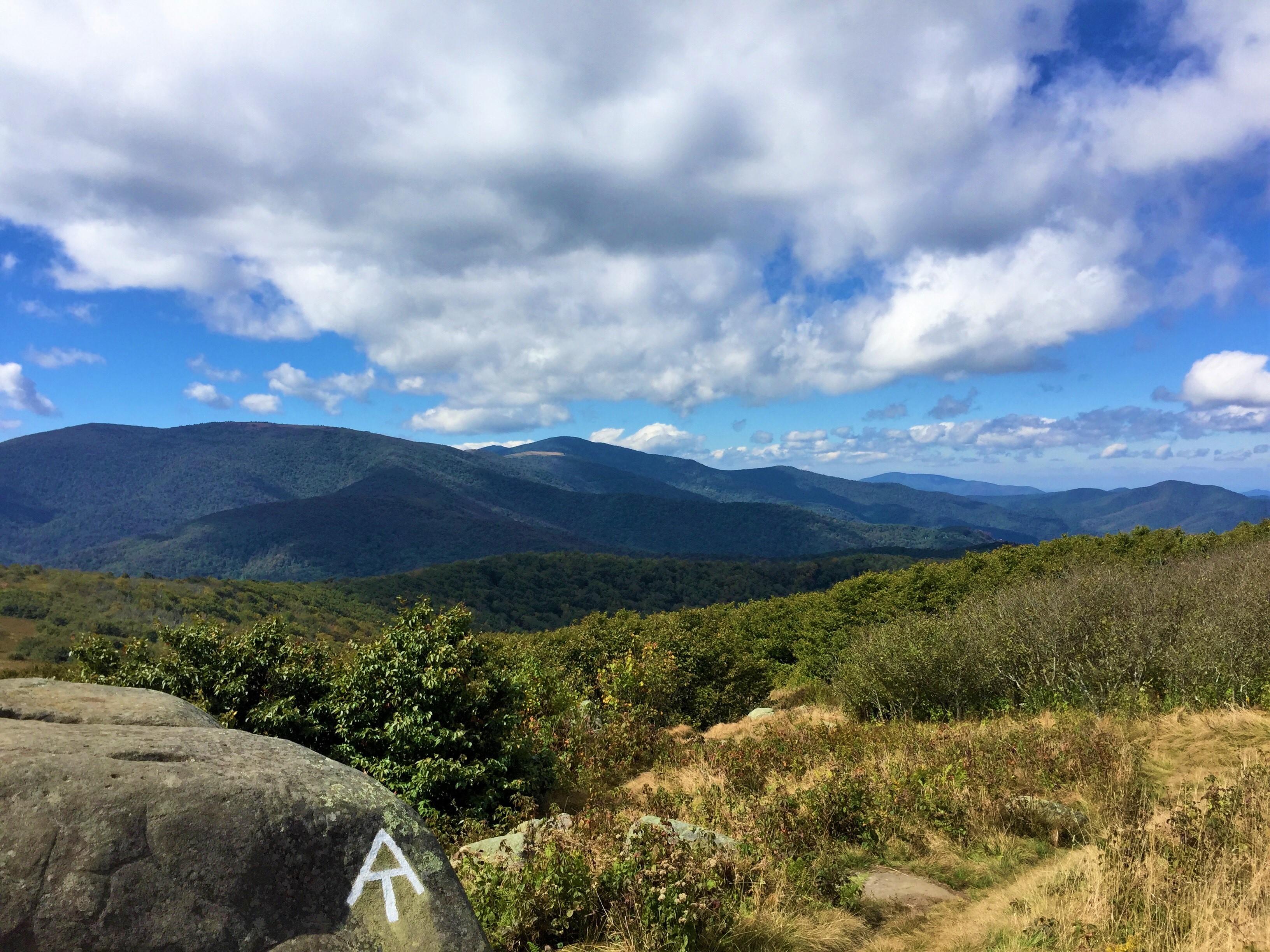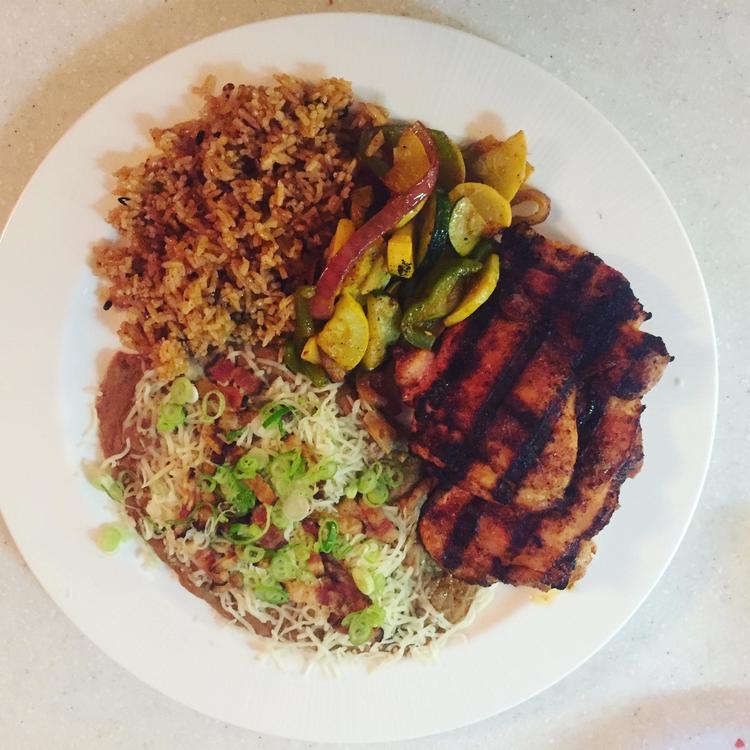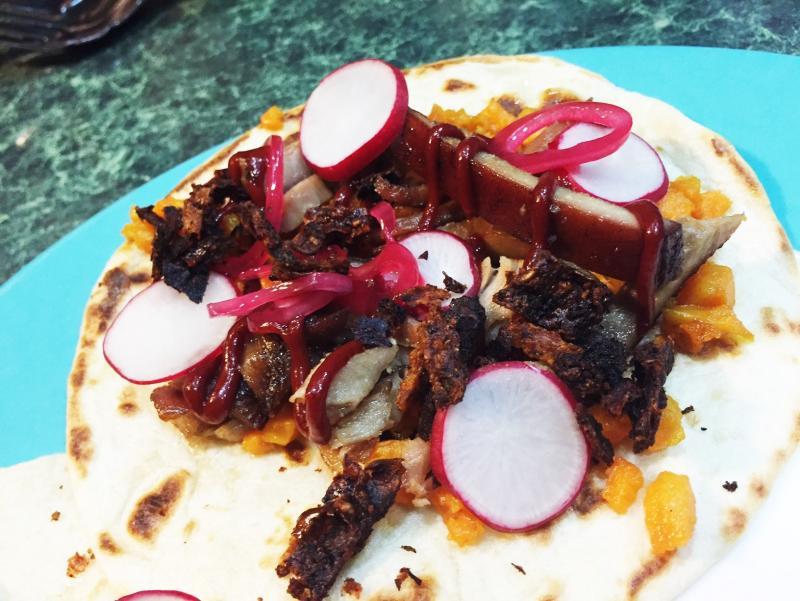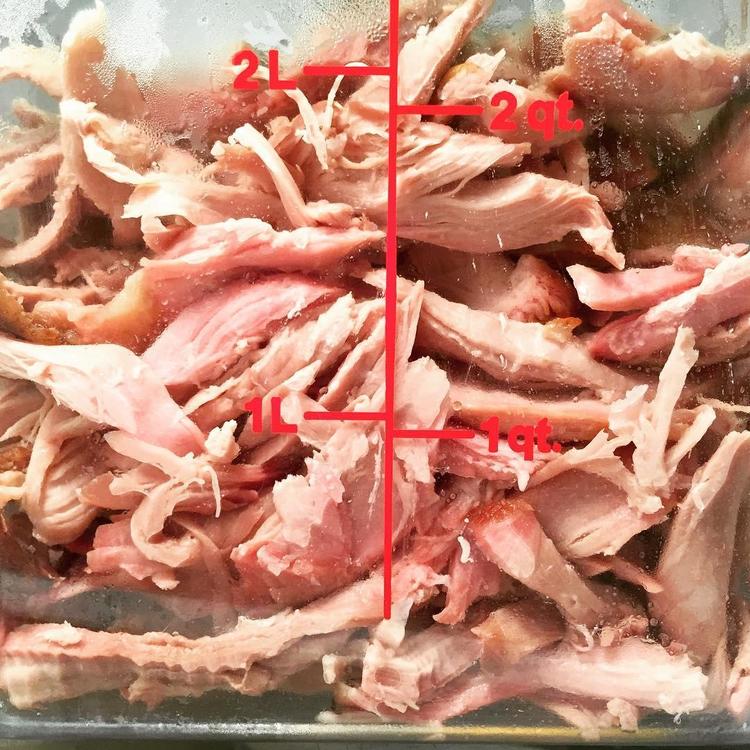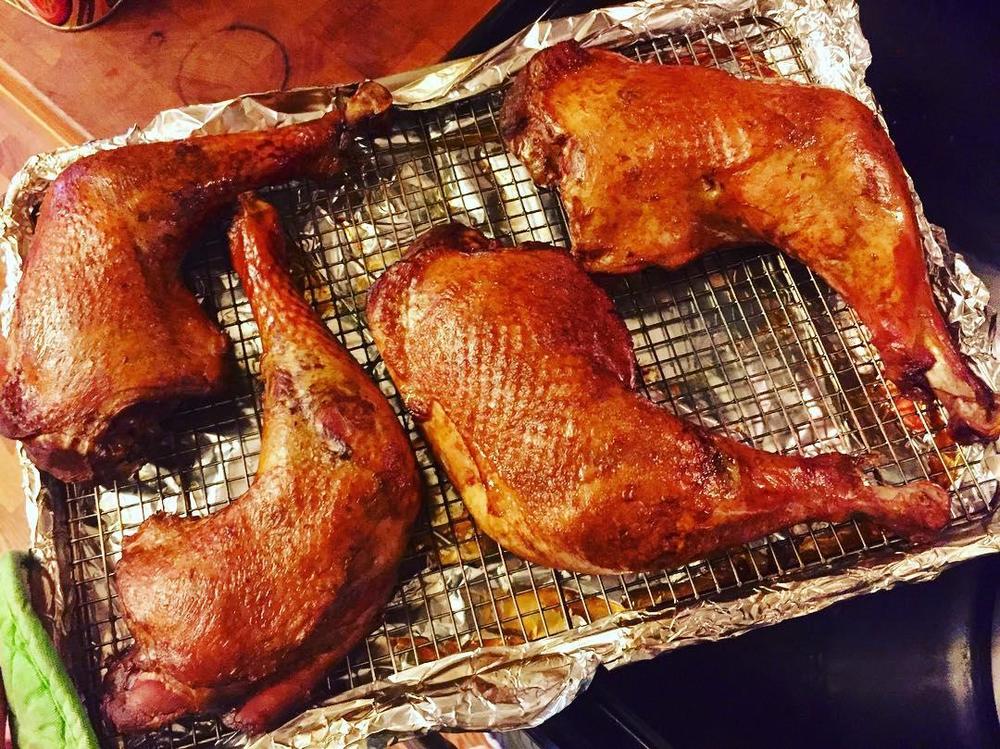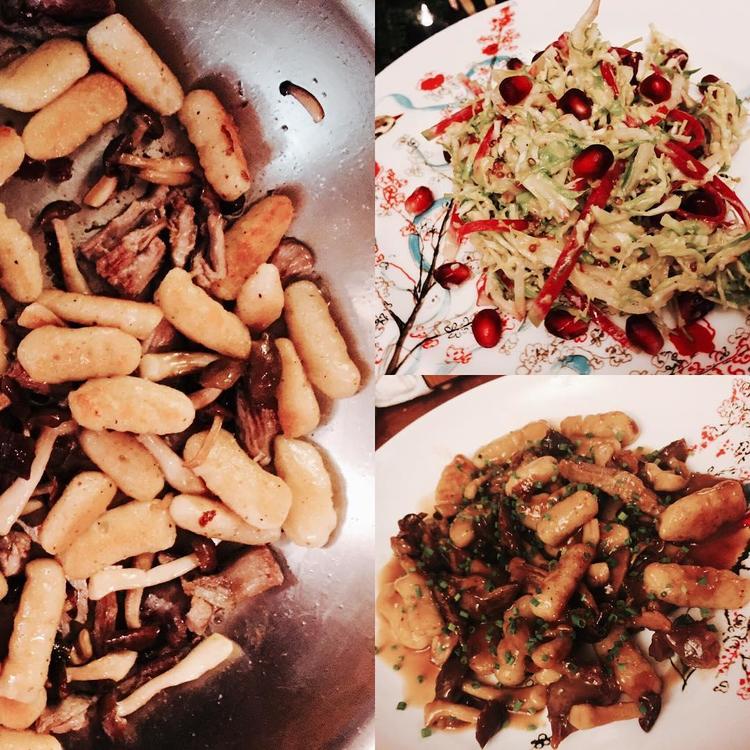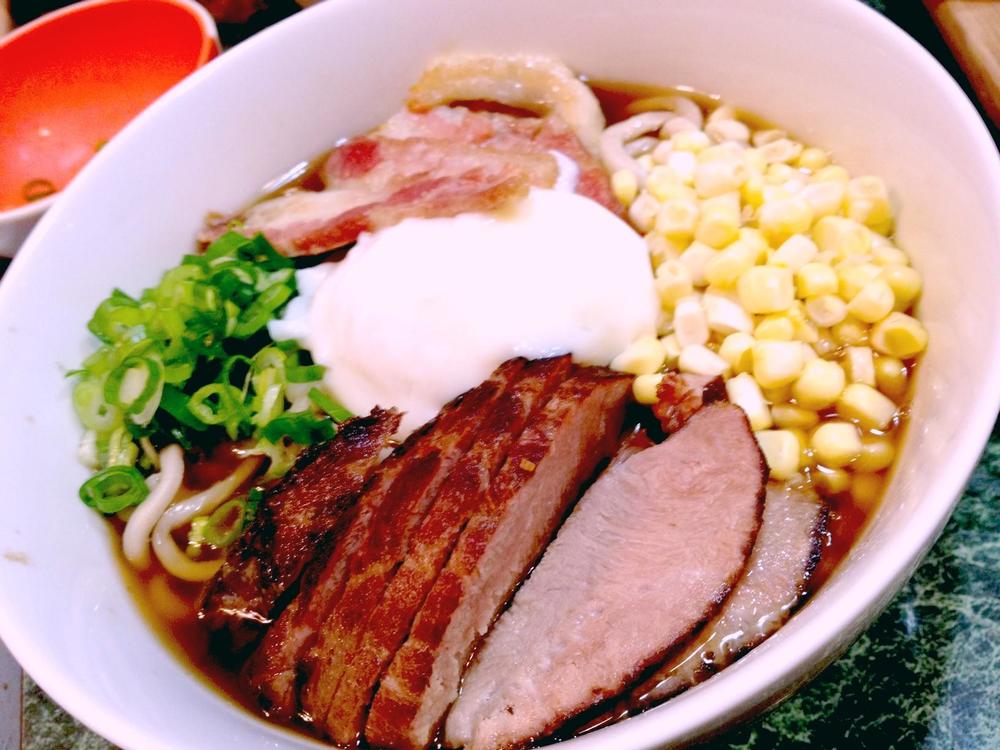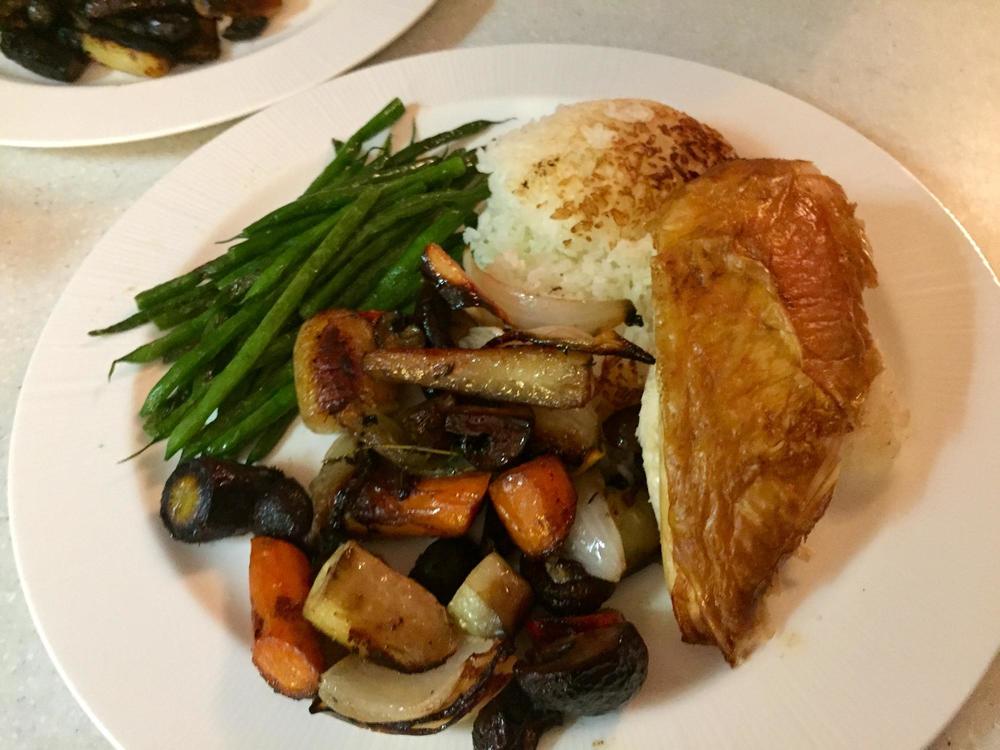-
Posts
1,807 -
Joined
-
Last visited
Content Type
Profiles
Forums
Store
Help Articles
Everything posted by btbyrd
-
-
I saw someone over at ChefSteps report success using 130F for 3 hours using mason jars.
-
I've also done the turkey tube using the dark meat, but I don't recommend it. Removing the tendons is a thankless and necessary task, and the end result looks better than it tastes. If you're going to do a roulade, you'd be better off doing it with breasts. The final deep fry was pretty epic though.
-
My, that's some uninformative sponsored content. It's supposed to be Sharma's "take" but it's written by someone else, and there are no photographs, only illustrations. Boo! (That's not a Boo at you, Anna... just a Boo at ChefSteps and the value they got for their marketing dollar.) Anyway, here's what you get if you follow the ChefSteps protocol for the dark meat, chill it down, and then retherm on a 225F smoker. And this is what it looks like after you remove the skin (cracklins!) and shred the meat. It is extremely close in appearance to good pulled pork barbecue; It is delicious. You can just cram it directly in your pie-hole, but it also works as an excellent starting point for more composed dishes. Here are a couple such dishes from Thanksgivings past. Up first is a Thanksgiving taco. Sweet potato hash underneath, with shallots pickled in cranberry jus, a cranberry BBQ sauce, smoked dark meat, and turkey skin cracklins for some crunch. My radish slicing skills have much improved since then. I served them with tempura green beans and some deep fried parsnip chips. It was maybe my favorite Thanksgiving plate ever. Traditional ingredients but unconventional preparations. Last year I made potato gnocci with the shredded dark meat, poplar mushrooms, and a turkey demiglace. It's a riff on mashed potatoes and gravy. The salad was made of shaved brussels sprouts, granny smith apple, watermelon radish, and pomegranate with an apple cider honey-mustard vinaigrette. You can also throw it on a sandwich and eat it like BBQ. Or just pile it on your plate and eat it straight up alongside your favorite sides. I should try to remember to take some pics of my white meat this year...
-
The problem is that queso is an inherently unnatural product, and Chipotle is wedded to only using "real" ingredients (for better or worse). Thankfully, their guac more than makes up for their queso. Every time I visit one of Chipotle's competitors, I'm disappointed. Moe's and Q'doba just aren't as good; they have too much behind the counter that they cared too little about. Muddy tasting rice. A million mediocre sauces and salsas. These places never tried to brand themselves on the quality or provenance of their ingredients because they can't. Variety may be the spice of life, but it's the death of quality in a fast casual dining establishment. Chipotle does more by doing less. They should take that queso off the menu.
-
I can vouch for using a chamber vacuum machine and water bath to make sangria. FWIW, chamber vacuums can produce results similar to ISI rapid infusion, but at the other end of the pressure spectrum. The downside is that your yield will be lower because the liquid rushes into your product. Sometimes this is an upside. I discovered this when compressing watermelon with tequila; the result was not only delicious boozy watermelon, but also delicious watermelonny booze.
-
It's also made with coconut tequila and boxed lemonade. A sign of the apocalypse perhaps? And thank God he's using a paper straw for that drink unnecessarily prepared in a plastic bag.
-

Should I start a blog with the recipes of Antoine Carême?
btbyrd replied to a topic in Cookbooks & References
I can't believe that no contemporary English translations of Careme exist! That's bonkers, given his historical importance. William Hall translated 3 of Careme's biggest works and published them in a single volume called "French Cookery" in 1836. Happily, this edition has been digitized and is available for free online via Archive.org. We live in amazing times. -
Wood is sanded before sealing to both clean it and to open the grain so that the oil will more easily penetrate it. Sanding between coats of drying oils is an optional step, and typically isn't done for the sake of "adhesion" (at least, given my limited woodworking knowledge) but rather to even out any streaks or drips; if you're going for a high-gloss shine -- like applying tung oil to finish the body of an electric guitar -- then you'll want to sand periodically during the finishing process. Otherwise, it's not necessary. Sometimes people will also wet-sand with finishing oil in an attempt to fill the grain on textured woods. But I don't think any of this is all that relevant to seasoning carbon steel or cast iron pans. And like the man said, it's not as though the surface of these pans is so smooth that polymerized oil won't stick to it. I've tried sanding one of my less desirable carbon steel pans, which is the odd-man-out of all my cast iron and carbon steel pans in terms of its ability to take seasoning. It didn't help. Granted, I didn't sand between coatings -- just enough to rough it up a bit initially with 600 grit sandpaper and 0000 steel wool -- but it didn't make a difference.
-
We do a fair amount of backpacking and camping in NC (and the surrounding high country of TN and VA). I'm going to leave backpacking out of this, because that's its own weird thing with its own weird constraints. But for car camping, I've found that few things are as valuable at the campsite as having a portable butane burner. I use an Iwatani 35FW, which comes with a handy-dandy carrying case. It's actually better than the burners on the 3 cheap gas ranges I've used long-term in rental properties. And the nice thing is, it's not a camping-only unitasker. Most people's kitchens, myself included, have garbage ventilation that doesn't allow them to properly sear meat without smoking out their entire house. The Iwatani allows you to take the fire outside. Or anywhere you want, really. It cranks out a ton of heat for its size and craps all over the standard 2-burner Coleman camp stove (which I also have). Just as important as having access to a reliable heat source is having cookware that cleans up easily. There's nothing worse than doing dishes in the freaking woods. Or trying to. So I take a nonstick pan with me, that can be wiped out with a paper towel before a quick rinse. I don't have a nonstick pot, but if I did, I'd take it with me too. I'll also plug for cook->chill sous vide as my preferred way to deal with protein. This is one place where "sous vide for insurance purposes" really shines. You can cook and pasteurize your proteins at home, chill them down, and pop them in the cooler until it's time for dinner at the campsite. You know everything's been thoroughly cooked through (and all the germies are dead), so it's not the end of the world if your fire's unevenly hot or the meat is a few degrees under in the center. I also like to bring my TS8000 blowtorch along for firekeeping duties. I also throw in my charcoal fan to work as a bellows. It's amazing how much wind (and heat) you can generate with a handheld fan. One of the most important things you can do when cooking is taking chance out of the equation. Primitive campsites introduce a lot of variables. But having access to proper heat sources (and torches/fans) can quite cut down on the most troublesome variable of all -- temperature. And if you can't have reliable heat on-site, sous vide can take care of that at home.
-
This is the slightly more detailed ChefSteps guide to SV turkey. No grilling, no Meathead.
-
+1 for the ChefSteps time/temps. Do the legs for 12 hours at 150, then drop the bath to 131, add your white meat, and go another 12 hours. 131 sounds insanely low for poultry white meat, but the results speak for themselves. The breasts can just be seared in a pan to crisp up the skin. I usually smoke the legs and shred them, though I did do the CS SV dark meat turkey tube one year and deep fried it for the final sear. If deep frying is an option, it's worth doing. Sears all sides evenly at once, and much faster than using an oven or broiler. If that's not an option, I'd chill the legs down a bit after unbagging them and use a very hot oven with convection. I have no idea why gfweb reports it being a PITA. I've never had an easier cooking experience than SV turkey breasts, and they always _always_ get rave reviews.
-
When I break down the big birds, I take off the white meat (with skin) and remove each leg at the thigh trying to get as much of the oyster as possible. The wings and carcass get roasted to make stock. I confit the legs/thighs SV in duck fat (like 144F for 24 hours), chill, unbag, and retherm on a 225F smoker for a couple hours until the skin looks crispy and amazing or I just can't stand it anymore. The skin gets removed (it usually comes off in one piece) and cut up for smokey cracklins. I pull the legs/thighs, trying to discard any tendons I might come across in the process. The result is fantastic. I'm from North Carolina (where were have actual barbecue) and I'd put my turkey-cue up against any pulled pork from anywhere. It's kind of amazing how closely smoked dark meat from a turkey can resemble smoked "the other white meat." I've also been known to reheat shredded smoked turkey in a nonstick skillet with some Benton's bacon fat. Delicious. I know this is all very sous vide-y, but after cooking a few turkeys this way I don't know that I'll ever go back to doing them conventionally. I don't particularly care for sous vide chicken, but SV turkey was a total gamechanger for me.
-
I did some cursory Googling and couldn't find much of anything about this style of "BBQ" (which, being neither smoked nor sauced, is about as much barbecue as the PA Dutch are Dutch). Anyway, my turkey move for the past few years has been to smoke and shred the dark meat while doing the breasts SV. White meat doesn't want to be pulled, and if you get it to the point where it's pullable, something horrible has happened. Sure, you can drown it in "juices" and pretend that the meat itself isn't dry, but we're all familiar with this kind of subterfuge -- it's the "drown it in gravy" strategy that so many have adopted to make their Thanksgiving meals more tolerable. (There's also the "drown yourself in bourbon" gambit, which can also be useful on Thanksgiving... but that's a solution to another problem.) All that's to say, I'd opt for the half-pan 'o shredded, and the half-pan o' sliced solution. The ChefSteps turkey breast is the best I've ever had, though I go just a bit higher temp-wise than they do (8-24 hrs at 135F). And it's *EASY*.
-
Sometimes I cure them, sometimes I don't; sometimes I'll cold smoke them, sometimes I won't. Sous vide 48 hours @ 60C is a good starting point (works well for beef cheeks too). Works great as a topping for ramen. You can also braise them to death in whatever fashion you most find delicious. Stew them down with wine, tomatoes, and aromatics, and you've got the starting point for some solid porkface pasta or pollenta. If you ain't got time for that, you can also pressure cook them.
-
My knowledge of the refrigerator technique comes from Modernist Cuisine and Dave Arnold. I frankly don't feel the need for it most of the time, as paper towels do a fine job. It can be useful on poultry skin if you want it super crispy. But I don't believe water vapor is going to condense on a warm piece of meat in the fridge, as condensation forms on cool surfaces rather than hot ones. And since I'm deliberately being a bit provocative in this thread, I'll go ahead and say it: If you feel compelled to blow dry a steak/chop/whatever (or put it in the fridge after blotting with paper towels) then your problem with searing isn't moisture-related. Your searing medium just isn't hot enough. Oh, I use my hair dryer for many uses for which it was not intended. I've certainly used it to light charcoal before, though my leaf blower does a better job. It's not the departure from intended use to which I object. But using a hair dryer on sous vide protein strikes me as unnecessary, unhygienic, and a bad technique that makes you more likely to overcook your meat.
-
Here's a controversial opinion that I don't think should be controversial: blowtorches suck. For searing, I mean. I would rather use pretty much anything else. Cast iron, carbon steel, deep frying, grilling, a charcoal chimney starter, a cheap nonstick pan from Ikea... all preferable to the abominable torch. Even with a Searzall. Do you like "crusts" that are somehow both weak *and* scorched beyond recognition? Do you like spotty, uneven sears that take forever to form? Do you find torch taste delicious? Do you live in a dorm? Are you, perhaps, on a camping trip, or driving across the country, or doing something else that involves being far away from a kitchen and actual cooking equipment? Then perhaps a torch is for you!
-
Good lord, people. Don't use a hair dryer on your meat; blot it dry with paper towels. If that's still not dry enough for you, plop it on a rack in the fridge for like 10 minutes. Refrigeration sucks moisture from the air, so your fridge is a great place to let surface moisture "flash off" (as Dave Arnold refers to the process). The air in your fridge isn't cold enough or conductive enough to really drop the core temp of your meat in that short amount of time, and it gives you a bit of extra insurance against overcooking during the final sear step. Hair dryers. Honestly.
-
I've cooked a lot of SV short ribs and the best approach I've found is to bone them out and trim off any exterior fat/connective tissue before cooking. Don't try to do with heat what you can do better with a knife. The whole point of low-temp short ribs is that they're low temp -- tender and steaklike. Anything much over 60C is a waste. If you want braised short ribs, then braise them (or pressure cook them).
-
Julia Child dropping some poultry knowledge. She goes over the difference between broiler, fryer, roaster, capons, and stewing chickens. Julia's opening is sure to put a smile on your face. Or my face, at any rate.
-
If you need to re-download the book, email them at nextebook@nextrestaurant.com .
-
I wish they would get on that No# 31 saute pan. I would have preordered one if it was available.
-

Whirlpool patent for sous-vide induction gizmo with magnetic stirrer
btbyrd replied to a topic in Kitchen Consumer
All this talk and I still have no idea what one would do with such a contraption.

